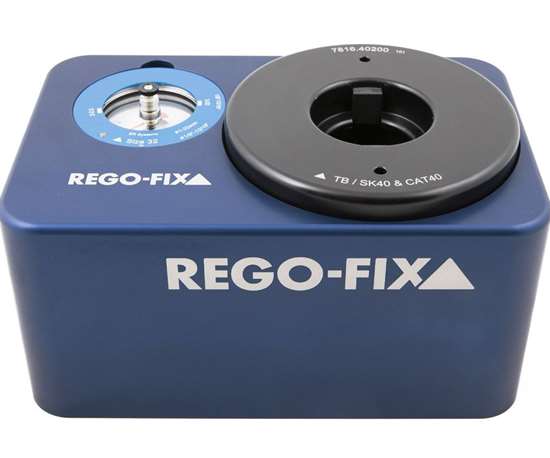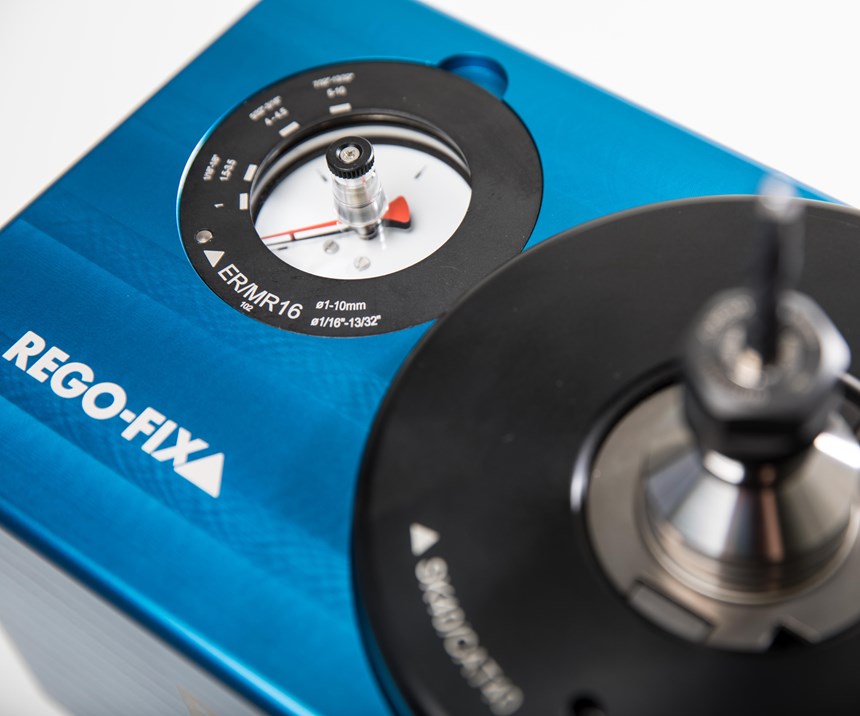System Ensures Properly Torqued Tools
A torque-assist system that’s designed to make assembling collet tools easy and fast can help shops avoid problems associated with improperly torqued tools.
#techbrief
Edited by Julia Hider
Collet-type toolholder assembly and setup have typically relied on manual methods that can be cumbersome, prone to errors and potentially waste time and money. Traditionally, operators must first check adjustment charts to reference torque values based on specific collet series holders and tool diameters. Then they have to find the right torque wrench, unlock it, set the torque level and re-lock it before tightening the collet retention nut on a toolholder. This procedure can cause shops to lose valuable production time and can lead to inaccurate torque settings that damage toolholders, or, in some instances, negatively affect workpiece precision.
This system can also lead shops to adopt bad habits in their quest to save time and simplify the setup process. Under deadline pressure or unsure of exactly what to do, shops might lock their torque wrenches at maximum values and leave them there, trying to cut corners with what seems like a quick solution. But nuts don’t all transfer the same amount of clamping force to the collet—some are more efficient than others. Shops that try to apply the same approach to every setup might end up with over-tightened tools because of improperly adjusted torque wrenches that transmit excessive force to the thinnest, most vulnerable parts of the toolholders. This force can damage toolholders, collets and nuts, and introduce runout that leads to rejected workpieces. Conversely, applying too little torque can be dangerous if it leaves tools loose enough to pull out of their toolholders. Some solutions to these setup problems substitute new complications for old ones by adding bulky hardware or complex, expensive digital technologies that change the setup process without necessarily improving it.
Featured Content
Furthermore, tolerances are tightening in certain industries such as medical and aerospace. For manufacturers working in these sectors, even the slightest deviation from the specifications can cause traumatic results, so they need a foolproof solution to ensure that all collet toolholders are consistently set to the correct torque levels. The Torco-Block from Rego-Fix is designed to solve this issue, taking the guesswork out of determining proper torque levels and making toolholder set up fast, easy and consistent.
The company developed the system after seeing the damaging consequences of over-torqued tools, including its own ER collets and nuts. The Torco-Block system has one gage that can virtually cover an entire collet series, according to the company. The device is designed to replace reference tables and torque wrenches, enabling operators of all skill and experience levels to measure the torque applied to the toolholder quickly and accurately.
The Torco-Block is an analog device that attaches to a workbench with six bolts in a 6.693- × 10.629-inch (170- × 270-mm) footprint. It includes a set of 10 color-coded indicator rings, each displaying the shank diameters for a specific type of collet. The operator places the appropriate ring on top of the unit, sets a single indicator to the appropriate shank diameter and uses a standard wrench to tighten the toolholder until the indicator needle lines up with the target size. A hydraulic system inside the device measures torque and displays it on the pressure gage on top of the unit. When the indicator needle lines up with the torque value, the operator knows that the adjustment is correct and complete.
The torque-assist system’s simplicity and flexibility make it easy to use for a range of common toolholders, as long as the manufacturer has set up the system to handle the full range of production hardware. Along with Rego-Fix ER collets, the Torco-Block handles other brands with compatible torque ratings, the system’s adapter set accommodates all standard spindle interfaces, including CAT, SK, BT, HSK and Rego-Fix Capto. Users insert the adapter into the top of the unit and turn it until it clicks into place. A standard Allen key tightens the recessed screws to hold the adapter in place.
Consistently applying the proper torque when assembling collet-type toolholders can improve tool performance, increase tool life and help shops achieve precision machined parts. Assembly-assist systems can give shops peace of mind, knowing that all their operators can easily comply with tool setup specifications.
Rego-Fix | 317-870-5959 | us.rego-fix.com/en
RELATED CONTENT
-
Selecting the Right Milling Tool for Any Machining Task
High-performance milling cutters combine high cutting data with long tool life and efficiency, but certain factors must be considered when selecting tools for different machining tasks.
-
Cutting Tool Coating Production
This article looks at the coating methods available for carbide cutting tools.
-
Understanding CNC Collet Chucks
Workholding for turning is usually fairly basic: The selection comes down to chucks or collets. This article looks at when to consider the collet chuck and what kind might be best for a given application.








